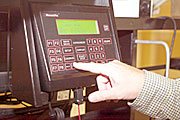Campus News
From right: Charles Atwood, coordinator of freshman chemistry; Bobby Stanton, laboratory coordinator; and freshman biology major Katrin Usifo watch freshman biology major Matthew Sokolik zero out MeasureNet?s spectrophotometer before the device is used to measure the elemental spectrum of a substance. (Photo by Peter Frey)
The perfect solution
Computer-based teaching revolutionizes freshman chemistry labs
By Phil Williams
phil@franklin.uga.edu
Each week, nearly 2,000 UGA students come into freshman chemistry labs, where they work with retorts and beakers as they learned in high school. But a new twist has been added to labs here--computer-based probes that allow students to perform bench science as researchers do.
The change has been dramatic and has improved instructional capabilities remarkably, according to Charles Atwood, coordinator of freshman chemistry.
"This brings us finally into the 21st century," he says. "It allows students to perform experiments quickly and accurately, and so far the results have been amazing."
A problem with freshman chemistry labs has always been the intense level of activity required of teaching assistants and professors. TAs particularly had to roam the lab constantly, answering questions, solving problems and giving advice. Now, a single TA at an integrated computer station can monitor the work of 25 students in experiments that test everything from temperature and spectral properties of liquids to the analysis of gases with a spectrometer.
The system, built by a Cincinnati company called MeasureNet, involves a series of small two-person computer workstations where students work on experiments, using specific probes for assigned experiments. The result has been an increase in learning speed and knowledge of equipment that is similar to that used in labs where many science graduates may one day work.
 "The system is extremely user-friendly, and most of it is menu-driven," says Bobby Stanton, general chemistry lab coordinator. "Each system controller is like the brain of the system, and they are really easy to upgrade."
"The system is extremely user-friendly, and most of it is menu-driven," says Bobby Stanton, general chemistry lab coordinator. "Each system controller is like the brain of the system, and they are really easy to upgrade."
Students have reported that learning to use the probes is quite easy, and in short order they are doing everything from determining what ions are in liquid to the elemental content of some substance.
Installation of the new lab system began a little over a year ago, and it has only recently been completed as new controllers were added when funds became available.
The upgrades in freshman chemistry labs aren't the only steps forward in the chemistry building. Richard Morrison has overseen an upgrading of the organic chemistry laboratory that now allows students to use cutting-edge diagnostic tools such as infrared spectrometry, gas chromatography and nuclear magnetic resonance imaging.
"Two years ago, this was a storage room," says Morrison, as he looks over the high-tech lab. He laughs when he says "this new equipment probably improves us by a century," but he's not really kidding.
The new equipment allows smaller groups to perform far more intensive analyses of substances than ever before in UGA history. The spectrometers and magnetic resonance equipment have been up and running for a while, but the gas chromatographs have just come online.
Few teaching labs in the country are so well-equipped, says Morrison. Instead of rudimentary tests, undergraduates can now unravel the actual structure of compounds--something limited in years past to graduate students and faculty. Morrison hopes soon to connect the new equipment in the organic chemistry lab to the MeasureNet system, too, making it easier for students to perform experiments and then save the data on computers.
One of the advantages of the system in the freshman chemistry labs is that, quite soon, all the information from student experiments will be saved to a network server in the chemistry building, from which it can be remotely accessed.
"So students could do an experiment here and then go back to their dorm rooms or houses and continue to work on it," says Atwood. Labs will not end when a student leaves the bench but go on as he or she has time later in the day or week.
While other U.S. universities are now using computer-storage capabilities for students' bench-science labs, most still require one computer for each workstation, which takes up a tremendous amount of work space. With a single computer hooked to much smaller workstations, which are mounted at eye level off the benches, there?s plenty of space for experiments at UGA. In fact, in terms of numbers of students, UGA is the largest user of this system in the country.
All students need to do with the MeasureNet system is plug in the preprogrammed probe for whatever experiment is being run on a specific day.
"We were lagging behind, but now we?re on the cutting edge," says Stanton. "The students and TAs have been impressed with what we can accomplish."